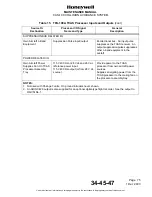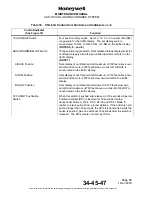
Page 84
1 Dec 2003
34-45-4
7
MAINTENANCE MANUAL
CAS-100 COLLISION AVOIDANCE SYSTEM
Use or disclosure of information on this page is subject to the restrictions in the proprietary notice of this document.
Table 18. CTA-81A Control Unit Controls and Indicators
Control/Indicator
(See Figure 10)
Function
ATC 1-2 Switch
Sets one of two Mode S transponders to be under control of the
CTA-81A Control Unit. The nonselected Mode S transponder is
put in STANDBY mode.
ALT 1-2 Switch
The switch sets one of two Mode S transponder altitude source
input ports.
Function Selector Switch
Rotary switch. Controls the operating modes of Mode S
transponder and requests the TCAS operating modes.
NOTE 1.
TEST Position
Holding switch in the spring-loaded TEST position for one second
starts the TCAS and Mode S transponder functional self-test. If the
TCAS processor Functional Test Inhibit program pin is strapped,
the TCAS functional test is prevented while the aircraft is airborne.
The TCAS flag shows TCAS on the RA/VSI display during the
functional test (approximately 12 seconds). The traffic display
shows TEST. A test pattern shown on the traffic display allows
verification of each type of intruder symbol. During the first three
seconds a lamp test is done on all segments of the RA/VSI. If a
failure is found during functional test, the TCAS flag continues to
display TCAS. Following the lamp test, a test fixed command is
shown until the end of test.
STBY Position
In-flight or on-the-ground puts the Mode S transponder and TCAS
in STANDBY mode (TCAS sensitivity level No. 1). In STANDBY
mode, transponder power is turned on but the transponder does
not transmit squitters or reply to interrogations. In STANDBY
mode, all TCAS broadcast, surveillance, and tracking operations
are made unserviceable and the traffic display is erased but for a
TCAS STBY mode annunciation.
















































